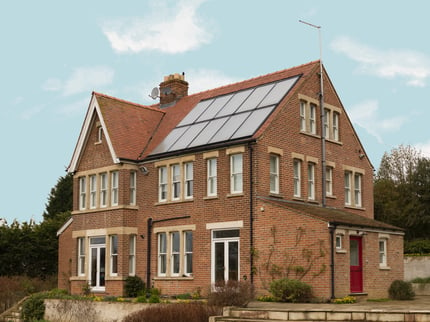
Mechanical ventilation with heat recovery (MVHR) extracts heat energy from exhaust air. However, it carries a high capital cost and case studies revealed that many...
The atBOS sensor network comprehensively monitors a building’s indoor environment and energy use. The data facilitates building management and can also be used in various independently assessed certifications relevant to its environmental, social and corporate governance (ESG) rating. This article introduces the main residential and non-residential certifications used in Britain.
 To a passerby, a building is bricks and mortar or, in the case of anything built recently, a more modern building material like timberframe or ceramics. To whoever runs the building, that’s merely the building’s envelope. A passerby doesn’t see the building as a dynamic entity with energy and water flowing in, heat and effluent flowing out and air flowing through. At its centre are the people who live, work, shop, play, learn, queue or do whatever else it is that the building is designed for.
To a passerby, a building is bricks and mortar or, in the case of anything built recently, a more modern building material like timberframe or ceramics. To whoever runs the building, that’s merely the building’s envelope. A passerby doesn’t see the building as a dynamic entity with energy and water flowing in, heat and effluent flowing out and air flowing through. At its centre are the people who live, work, shop, play, learn, queue or do whatever else it is that the building is designed for.
For a developer or an owner, there is something else flowing through the building: money. There are direct costs like energy and water and there are direct payments such as rent and, in many cases, there is also investment.
Many of today’s investors consider not only the projected returns on an investment but also the likely impact of their investment on social and environmental impacts that they care about.
The impact of an investment is usually measured as an environmental, social and corporate governance (ESG) rating, which encompasses an extremely broad range of factors from the building’s carbon footprint to its waste disposal system to the wellbeing of anyone in the building. The complexity of different factors has led to an ongoing controversy about inconsistency between different ESG rating systems, which often score the same project very differently.
However, any ESG rating is improved by ensuring that a building’s indoor environment is comfortable and healthy and minimising the energy required to keep it that way, which is where the Atamate Building Operating System (atBOS) comes in. All atBOS functions are based on data, which can be viewed in realtime or reviewed retrospectively.
Its principal framework is a network of ceiling sensors which have two functions:
 They monitor the indoor environment, storing parameters that can be used to assess indoor air quality, thermal comfort and background noise, which affect the wellbeing of anyone in it.
They monitor the indoor environment, storing parameters that can be used to assess indoor air quality, thermal comfort and background noise, which affect the wellbeing of anyone in it.From the outset, atBOS was designed to be flexible enough to incorporate sensors or meters from different suppliers that use different connection types. That’s why the sensor units can interface with sensors or meters operating on different protocols. For example, a gas meter requiring a Modbus connection can be plugged into the nearest ceiling sensor, which then transmits its data through the wireless network.
Combining data from sensors and meters gives a picture of how energy and water are used within the building and, in the case of energy, how its use affects the internal environment experienced by the people within the building. Reviewing that data facilitates the management of a building, such as by identifying where changes to service use may improve energy efficiency or address parts of the building where the indoor environment is persistently substandard.
For a development where investment is required, atBOS data can be used to apply for or demonstrate compliance with various standards and certifications that count toward ESG ratings.
The UK building regulations mandate energy efficiency should be rated based on an assessment of its projected performance using the standard assessment procedure (SAP). There is no requirement for a post-occupancy evaluation to confirm the accuracy of the assessment which, in many cases, is poor. When a building’s in-use performance is assessed, there is often a performance gap between the SAP projection and the actual energy use.
 Our view is that if domestic heating is to be decarbonised by 2050, the goal set by the government’s 2017 Clean Growth Strategy, there is little point in using demonstrably unreliable projections, and we have argued that energy assessments should be based on direct measurement of energy use.
Our view is that if domestic heating is to be decarbonised by 2050, the goal set by the government’s 2017 Clean Growth Strategy, there is little point in using demonstrably unreliable projections, and we have argued that energy assessments should be based on direct measurement of energy use.
We are not alone in our opinion. Such an approach has already been adopted by the Greater London Authority (GLA) with their Be Seen energy monitoring guidance. Even if in-use monitoring is not adopted by the national regulations, more local authorities will likely follow the GLA in incorporating it into their own decarbonisation strategies.
In addition to any requirements imposed by planning authorities, atBOS can play a part in independently administered frameworks and certifications that can count toward an ESG rating.
The data collected by atBOS can provide a comprehensive post-occupancy evaluation, which is a key part of the Soft Landings framework administered by the Building Services Research and Information Association (BSRIA).
Soft Landings provides a framework for addressing those teething problems by keeping the design and development team engaged after the building is handed over to its owners and the residents move in. While the framework operates at all stages of development starting with the initial design, its main value is in identifying areas of possible improvement once the building is occupied, particularly where the residents do not interact with the building as the designers anticipated or where an aspect of construction or installation was not carried out correctly.
 The Passivhaus Trust administers two widely recognised standards for energy efficiency: Passivhaus for new builds and EnerPHit for renovations. Both are based on the sort of energy efficiency measures that atBOS is designed to monitor and, through service automation, to deliver.
The Passivhaus Trust administers two widely recognised standards for energy efficiency: Passivhaus for new builds and EnerPHit for renovations. Both are based on the sort of energy efficiency measures that atBOS is designed to monitor and, through service automation, to deliver.
Where we differ from the Passivhaus Trust is in their recommendation to use mechanical ventilation with heat recovery (MVHR), which involves a greater capital cost than is likely to be justified in most British developments. Our view is informed by the work of Paola Sassi of Oxford Brookes University, who showed that MVHR is better suited to the climate of Germany, where the Passivhaus concept originated, than to the milder British climate.
Our operational research has shown that a combination of high-quality building fabric and atBOS-automated building services can deliver the Passivhaus standard of energy efficiency without the capital expenditure and embodied carbon costs of installing MVHR.
Whether or not a building uses MVHR, atBOS data can confirm compliance with the Passivhaus and EnerPHit standards, which include the following core parameters:
|
|
Passivhaus |
EnerPHit |
|
Primary energy demand* |
≤ 135 kWh/m2/yr |
≤ 135 kWh/m2/yr + heat load factor |
|
Primary Energy Renewable (PER)**/ Energy Use Intensity (EUI)*** |
≤ 60 kWh/m²/yr |
PER: ≤ 71 kWh/m²/yr (cool temperate climate) PER: ≤ 65.5 kWh/m²/yr (warm temperate climate) |
|
Space heating demand |
≤ 15 kWh/m²/yr |
≤ 20-30 kWh/m²/yr |
|
Space cooling demand |
≤ 15 kWh/m2/ yr |
≤ 25 kWh/m2/yr |
|
Specific cooling load |
≤ 10 W/m2 |
≤ 10 W/m2 |
|
Airtightness |
≤ 0.6 air changes/hr @ n50† |
≤ 1.0 air changes/hr @ n50† |
|
Summer overheating |
Max 10% > 25°C |
Max 10% > 25°C |
*All energy supplied to the building for all uses, excluding energy generated onsite.
**All energy supplied to the building generated from renewable sources.
***Total energy use by floor area.
†50Pa differential across building envelope.
The concept behind Energiesprong is that a new building or renovation can be designed to net-zero operational carbon emissions from the outset, and any extra cost incurred is paid back through energy savings.
There are two possible roles for atBOS in the Energiesprong process:
The first arises from our own process for renovating a building [PDF] for energy efficiency being similar to Energiesprong’s: the cost of the renovations needs to be balanced against the likely benefits in terms of both reductions in greenhouse gas emissions and costs. We recommend that any renovation should be based on a thorough understanding of the building being renovated, which is best achieved by installing the atBOS sensor network first and using its data to inform the renovation.
The second stage involves making atBOS part of the design, whether for a renovation or a new build. The data it collects can be used to verify that the efficiency improvements do indeed pay for themselves within the projected time, and automating building services can contribute to the efficiency improvements.
The UK building regulations treat non-residential buildings similarly to residential, in that efficiency assessments are based on projected rather than measured energy efficiencies albeit using the simplified building energy model (SBEM) instead of SAP. Our view is that prioritising projections over in-use data is an approach as flawed in non-residential buildings as in residential, and ongoing monitoring and automation by atBOS can deliver similar improvements.
Further, there are now several certifications for commercial buildings that may count toward a firm’s ESG score.
 BREEAM
BREEAMThe most commonly used certification for British non-residential buildings is the Building Research Establishment Environmental Assessment Method (BREEAM), which was introduced by the Building Research Establishment (BRE) in 1990.
The BREEAM certification was originally intended to assess environmental sustainability but now covers a broad range of areas relevant to ESG, including health, wellbeing and management practices.
In 1998, the US Green Building Council introduced the Leadership in Energy and Environmental Design (LEED) rating system, which covers very similar areas to BREEAM. The USGBC claims that LEED is the most widely used green building certification worldwide although, according to a 2020 comparison by BSRIA, there are more than five times more BREEAM-certified than LEED-certified projects worldwide.
In the UK, LEED is mostly used for buildings owned by US-based firms. However, the BSRIA comparison concluded that neither BREEAM nor LEED was particularly superior to the other.
The International Well Building Institute (IWBI) introduced the WELL standard in 2014. It differs from BREEAM and LEED in that it is primarily concerned with factors that affect the wellbeing of people working in a building rather than its energy efficiency.
The atBOS sensor network collects data on many of the parameters considered by WELL, such as indoor air quality, thermal comfort and background noise. It also collects data on room occupancy, which can be used to minimise the energy used to meet the WELL standards. By combining data on occupancy with the parameters measured by WELL, atBOS ensures that the assessment is based on the environment that the building’s users experience and avoids using energy heating, cooling or ventilating empty rooms purely to meet the WELL standards.
The National Australian Built Environment Rating System (NABERS). In Britain, NABERS UK is administered by the BRE alongside their own BREEAM certification. It is specifically aimed at office buildings, for which it compares energy consumption against a set of benchmarks.
Using atBOS to monitor energy consumption can establish whether the building is meeting those benchmarks but more proactively, it can integrate data from meters that reveal where and how energy is used within the building. The more granular the data, the easier it is to  identify any possible sources of inefficiency that could be addressed by maintaining or upgrading devices.
identify any possible sources of inefficiency that could be addressed by maintaining or upgrading devices.
Whatever the type and purpose of the building, it is good practice to maintain a comfortable and healthy indoor environment, to minimise the cost and environmental impact of the energy required to do it and to keep on top of maintenance issues. The various standards and certifications described above provide a guide to good practice and confirm it is being followed, but they are not an essential part of it.
The atBOS network can deliver the benefits of good practice with or without being tied to an independent standard. Moreover, its inherent flexibility enables it to be continuously upgraded and modified throughout the lifespan of the building, incorporating new sensors and meters if required.
If you’d like to know more about how the atBOS platform can meet independent standards, ask us on the form and we'll be happy to discuss it.

Mechanical ventilation with heat recovery (MVHR) extracts heat energy from exhaust air. However, it carries a high capital cost and case studies revealed that many...

Mechanical ventilation with heat recovery (MVHR) extracts heat energy from exhaust air to pre-heat incoming outdoor air.
However, it is expensive to install and case...